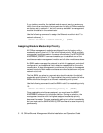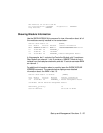
3 - 22 ONline Ethernet Management Module Installation and Operation Guide
By following this guideline, you will avoid having security configuration
information restored incorrectly in the unlikely event both the master EMM
and concentrator power fail concurrently, with at least one slave EMM in
the concentrator. In this scenario, the slave will power up and become
master, and will configure a module's security settings according to the
information stored in its memory. This information may be different than
the previous master EMM's information if you made security configuration
changes using the slave rather than the master.
Establishing Remote Logins
The TELNET command and the REMOTE_LOGIN command enable you to
log in remotely to any EMM on the network, and to manage the network
remotely (from a terminal attached to a remote EMM, or from a
workstation with Telnet support). You can manage an EMM across any
number of bridges and routers.
You must be logged into the local concentrator before you can issue the
TELNET command or the REMOTE_LOGIN command. Once you are
connected to the remote EMM, you must enter that EMM's password.
Then, all the commands you issue are for that EMM and are identical to
those issued under a local login.
As shown in Figure 3-2, once you are connected to the EMM in
Concentrator C, you can remotely log in and manage the EMMs in
Concentrators A and B.


















